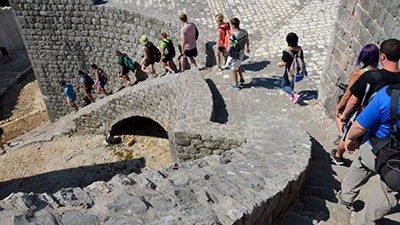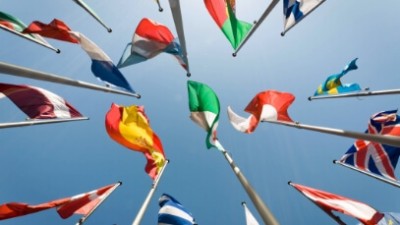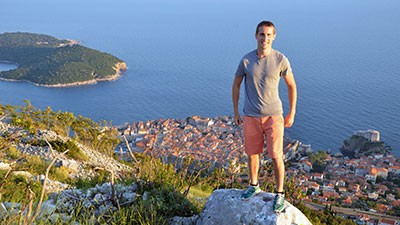Living in Zagreb
- RIT/
- RIT Study Abroad/
- Get Started/
- Study Abroad at an RIT Global Campus/
- Study Abroad at RIT Croatia - Zagreb/
- Living in Zagreb
Housing
Students will live in fully equipped apartments coordinated by the RIT Croatia International Student office staff. Apartments are available only as double shared-bedroom apartments. Utilities are included in the price of the housing. Students are responsible for cleaning, taking out the garbage to the designated bins/dumpsters, and making sure that broken or damaged house items are immediately reported to the International Student Office Croatia staff and to the landlord. Students will receive apartment policies/rules during the Croatia in-country orientation.
All apartments are equipped with bedding, linens, towels, kitchen appliances, dishware and glassware, clothes washer, television, and wifi. None of the apartments have clothes dryers (most people dry their clothes on a clothes rack). Apartments may be a 20-30 minute walk or public transportation ride to campus.
Please note that students on this program may be placed in mixed-gender apartment-style housing in which bedrooms are separated by gender, but the apartment itself has students of the opposite gender.
Food and Dining
Places to buy food include smaller mini-markets, supermarkets, fresh green markets, and local restaurants. Local cuisine is influenced by German and French cuisine. There are also some traces of Turkish or Greek influences, particularly in fast food. There is a growing food culture in Zagreb, and many new restaurants have opened in the last few years.
The tap water in Croatia is drinkable and of very high quality. The water contains a high mineral content, important to know when you use a dishwasher or an iron.
You can cook at your apartment, which is the most affordable option. Students can also eat at student restaurants (“menza”), where Croatian students have subsidized prices.
How can you avoid seafood? If seafood is present in a meal, the fact is usually stated with pride on the menu. Fish is called “riba” (reebah) in Croatian, and clams are called “školjke” (shcolke). To make sure, always ask the waiter.
Almost all grocery stores are open from 7:00 a.m.-9:00 p.m. You can’t buy food after 9:00 p.m. except in restaurants. Grocery selection is limited compared to the U.S.
In Croatian restaurants, there is no doggy bag concept; portions are smaller compared to the U.S. There are only a few fast food options, but there are a lot of bakeries where you can buy snacks, pastries, etc. There are many pizza places, and some restaurants deliver. Popular food delivery services in Zagreb are Wolt and Glovo.
Excursions
Students in Zagreb will participate in excursions as part of their study abroad experience, which are included in the program fee. More details on the excursions will be available once you arrive in Croatia. Excursions may include:
Plitvice Lakes National Park: On this one-day field trip (Saturday or Sunday), you will visit Plitvice Lakes National Park, view 16 beautiful lakes, enjoy the diverse plant and animal life, and observe over 50 species of butterflies. Lunch is usually included.
Visit to Krka Falls & Split: Krka National Park is situated along the Krka River in southern Croatia and is known for seven waterfalls and multiple nature trails. The nearby town of Split, located on the Dalmatian Coast, is known for its beaches and the fortress-like complex.
Trakošćan/Zagorje: Trakošćan castle is worth a visit for its well-presented museum and attractive grounds. The town of Zagorje offers delightful villages, medieval castles, endless vineyards, and thermal springs that speckle its rolling hills.
Istria Weekend Trip (Friday, Saturday, and Sunday): On this three-day excursion, visit four unique cities over the weekend: Pula, Porec, Motovun, and Rovinj.
In addition to planned excursions, the Zagreb campus offers nearby entertainment options, including the cinema, concerts, museums, sightseeing, music clubs, and local community experiences.
Things to do Around Town
The city of Zagreb consists of Upper Town and Lower Town, connected by a Funicular Railway that climbs the hill between the two areas. Upper Town and Lower Town each have plenty of cafes, restaurants, museums, and historical sites.
Highlights
Tkalčićeva Street: A main street in Zagreb’s city center lined with restaurants, cafes, and art galleries.
Ban Jelačić Square: Located in Lower Town, this expansive square is great for people watching and exploring.
Dolac Market: Located in Upper Town, this daily market features farmers selling fresh produce and stalls sampling local foods.
Lotrščak Tower: Climb the spiral staircase to the wooden deck of this 13th-century tower built as protection from the Turks and enjoy a 360-degree view of the red-tiled rooftops below.
Stone Gate: Medieval stone gate in town with a Virgin Mary shrine popular for prayer and candle lighting.
Strossmayer Promenade: One of Zagreb's beautiful promenades, especially popular in summer when artists flock here. The tower nearby offers stunning views.
Avenue Mall & Arena Mall: Shopping malls with stores, food, and a movie theater.
Taste Traditional Ŝtrukli: When taken to try štrukli in a traditional local restaurant, most first-time visitors are impressed by the gentle taste of the soft dough, creamy cheese, eggs, and sour-cream sauce. Many venues pride themselves on their štrukli, although the kitchen at the landmark Esplanade Hotel provides some of the best - if not the best - in town.
Participate in Špica: The local custom of špica is the Saturday morning habit of having coffee in Zagreb’s city center. More specifically, it takes place where Gajeva meets Bogovićeva and Preradovićeva by the flower market on Cvjetni Trg and between 11:00 a.m. and 2:00 p.m. after everyone has paid a visit to the Dolac market across the main square.
Botanical Gardens: The Gardens form the east-west anchor of the ‘Green Horseshoe’, a U-shaped band of greenery laid out by Milan Lenuci in the 19th century. Nearby but removed from the bustle of the train station, it offers a wonderfully relaxing way to escape the busy city.
Britanski Trg: On Sundays, the fruit and vegetable stalls that fill Britanski Trg during the week are cleared away, and an attractive bric-a-brac and antique market is laid out.
Maksimir Park and Zoo: Maksimir Park comprises 18 hectares (45 acres) of welcome greenery, opened to an appreciative public in 1794.
Hiking and Skiing at Sljeme: The highest peak of Medvednica Nature Park near Zagreb; Sljeme is also the name used to define a series of accessible slopes that welcome hikers and ramblers all year round. They’re best known for their climbing and skiing.
Local Parks: Visit Zagreb’s most famous parks including Jarun lake (called Zagreb’s sea), Bundek lake, Ribnjak, Art Park Zagreb, Zrinjevac.
Museums
Zagreb is a museum lover’s paradise, offering more than 20 museums. Some notable ones include:
Museum of Broken Relationships: Dedicated to failed love relationships, exhibits include personal objects left over from former lovers, accompanied by brief descriptions.
Museum of Illusions: Attraction featuring various optical illusion exhibits and a "smart playroom" with games and puzzles.
Arts and Crafts Museum: The museum exhibits furniture, textiles, metal, ceramic, and glass ranging from the Middle Ages to today.
Museum of Contemporary Art: Croatia's largest and most modern art museum.
Zagreb City Museum: Exhibits the cultural, artistic, economic, and political history of the city.
Day Trips
Plitviče Lakes National Park: A forest reserve in central Croatia known for a chain of 16 terraced lakes, joined by waterfalls that extend into a limestone canyon. Walkways and hiking trails wind around and across the water. Approximately 2 hours east of Zagreb.
Istria: A pastel-colored seaside town on the Adriatic Sea. Approximately 2 hours and 40 minutes west of Zagreb.
There are many tour operators that offer tours that will introduce you to all that Zagreb and the surrounding areas have to offer, including sightseeing tours, nature tours, historical/heritage tours, and day trips. Ask your RIT Zagreb staff for suggested tour operators.
Theaters
Zagreb theaters are the best places to visit for a cultural showcase. Even though there are theaters that don't offer performances in English, a few, like the Croatian National Theatre, perform shows both in both English and Croatian. Every theater has its distinctive style, but they all display the opulence of Zagreb's developed theater life. Whether it is comedy, drama, opera, ballet, a contemporary play, or a puppet show, Zagreb offers you a fantastic choice of shows.
Movies
Cinestar Zagreb offers a variety of movies.
Student Life
Most RIT Croatia students are involved in extracurricular activities, ranging from recreation to clubs and volunteering in community service projects. Trips to museums, local attractions, and concerts are also available.
RIT Croatia’s student government has a wide variety of clubs to meet the demands of its students. RIT Croatia has several active clubs, including the Business Environment Exploration Club, Investment Club, E-Sports Club, Robotics Club, and Volunteer Club.
RIT Croatia organizes activities and fun campus events like movie nights, game nights, stress breakers, and sports days.
Local Culture
Locals in your host country will likely be understanding and will not take offense at social blunders, provided they arise from ignorance rather than malice. However, you will be far more comfortable and welcome if you acquaint yourself with local ways of doing things. It’s important to remember that as a guest in your host country, you must adapt to the customs and social behavior of the region – not the other way around.
Socializing
- Most Croatians speak some English, but trying to learn some Croatian words and phrases is much appreciated.
- Croatia takes pride in its coffee culture; many meet friends or colleagues over leisurely cups of coffee. Coffee to go is rare. Some cafes might offer coffee only and no food (however, bringing your own snack to enjoy with your coffee is acceptable).
- Coffee shops are prevalent however, you will not find commercial coffee chains.
- Be aware that some places in Croatia may only accept cash, particularly in cafés, bars, and small restaurants.
- The concept of siesta is a part of the elder generation’s daily routine. Between 2 p.m. and 5 p.m., avoid making too much noise or phoning a local, as this is national naptime, particularly on the coast. Although rare today, don’t be surprised if some stores close in the afternoon.
- It is common for Croatians to speak loudly and be animated in conversations. This is assumed to reflect passion and expressiveness rather than anger.
- Generally, Croatians do not touch each other when they speak, especially when encountering someone for the first time. Light touching (such as a tap on the shoulder) can be common when a relationship has been established. Public displays of affection, such as kissing and hugging, are acceptable.
- Croatians tend to be extremely punctual and expect others to be on time. That being said, punctuality is more important in a professional setting than social ones. Friends will forgive tardiness so long as it is not a recurring behavior.
- Putting your feet up on couches in public spaces is considered rude and inconsiderate, especially at tables and the back of other people's seats. It is even more unacceptable to put your feet up while wearing shoes. It is a good form to keep your feet off any surface other than the floor or ground.
Dining/Meals
- Table manners are relatively casual as people like to eat and chat at meal times.
- With most Croatians being Catholic, it’s customary for some to say prayer or thanks before a meal. So, wait a little to be sure you’re not digging in too early.
- Croatian hospitality requires the host to ensure you are full and happy when eating at a friend or relative’s house. There is an emphasis on family, friends, and food. Offering drinks, pre-meal snacks, a meal, a second helping, even a third helping, cake, coffee, and more drinks to guests is a must. You should not decline as a guest, as saying no would be considered rude. Instead, take a small first serving, allowing you to accept a second helping.
- It is considered rude to place one’s hands below the table. Instead, Croatians tend to keep their hands above the table.
- In Croatia, lunch is considered the day's main meal and may consist of multiple courses.
- It is very common for a glass of wine to accompany the meal and for people to toast. They will raise their glasses and say ‘živjeli’.
- If eating in a restaurant or cafe and your Croatian counterpart insists on paying, let them pay. However, don’t take advantage of their hospitality; make sure you pick up the tab sometimes as well.
- Tipping your server in a restaurant is standard practice – 5%-10% on your bill is typical. There’s no rule that you have to tip, but it’s considered good etiquette if you do. If you pay with a credit card, leave the tip in cash.
- When purchasing food items, remember that the price/quantity ratios are much different than in the U.S. Food prices may be similar, but the package size may be smaller.
Safety
- Relations between the U.S. and Croatia are very strong. The U.S. established diplomatic relations with Croatia in 1992.
- Traveling in Croatia is generally safe and is highly rated for its safety index. Visitors of Croatia seldom face any severe threat during their stay in the country; however, pickpocketing, petty thefts, bag snatching, and ATM scams do happen, so it is important to be aware of your surroundings.
Religion
- The constitution of Croatia defines all religious communities as equal by law and separate from the state, and the country has no official religion.
- The Dubrovnik community is very inclusive and receptive towards various ethnicities and religions. The largest religion in Croatia is Catholic. More than 80 churches are scattered around Dubrovnik, the majority of them within the Old Town. Dubrovnik also has an Orthodox Church, synagogue, and Islamic Center.
Dress/Clothing
- Wearing swimwear (with no cover-up) around town or walking around shirtless may incur fines.
- Bring one set of business clothes for in-class presentations, Career Education Day, and other slightly more formal events.
Meeting and Greeting
- Greetings on initial meetings will be formal and reserved.
- In some cases, men and women will kiss each other on each cheek, which is a sign of a good friendship. Wait until the Croatian initiates this form of greeting.
- Address people with their titles plus surnames. Only close friends and family members tend to use first names. Never jump to first names terms without being invited to.
Gestures
- Croatians usually only point their index finger when arguing or intending to belittle someone. If someone needs to point towards a person or object, politely use the whole hand or nod with one’s head.
- Bending the middle and ring fingers with the index and pinkie fingers extended is rude.
Topics To Avoid
- Comparisons to anything Serbian can still be a touchy subject for some.
- Do not refer to Croatia as Yugoslavia or to a Croatian as ‘Yugoslavian’. As a nation, Croatia has endured many difficulties asserting its independent identity from surrounding countries and cultures.
- Discussing national politics with Croatians can be sensitive because of widespread nationalistic views. Discussing other ethnicities of Yugoslavia, as well as religious issues in casual conversation, are considered taboo.
History
Croatia has a long and eventful history. Hungary, Venice, Napoleon, and Austria alternately ruled Croatia for centuries. After WWI, Croatia became part of Yugoslavia along with Serbia, Slovenia, Bosnia, Montenegro, and Macedonia. Croatia gained independence from Yugoslavia in 1991 and was immediately thrust into the devastating Bosnian War from 1991-1995. Post-war recovery led to improved economic conditions, the rebuilding of infrastructure, and acceptance into the European Union. Today, Croatia is a vibrant country with a bustling economy and natural beauty. It is also known for being a popular tourist destination.
Weather
The climate of Croatia is classified as a warm, temperate Mediterranean climate with dry, warm summers and moderate, wet winters.
The summer months of July and August are typically hot and ideal water temperatures for swimming.
Winters are cooler and wetter, though still pleasant enough. Interior parts of the country may experience snow during the colder months.
Average temperatures:
Summer
Dubrovnik 70-80 Degrees
Zagreb 65-82 Degrees
Winter
Dubrovnik 40-50 degrees
Zagreb 32-47 degrees





